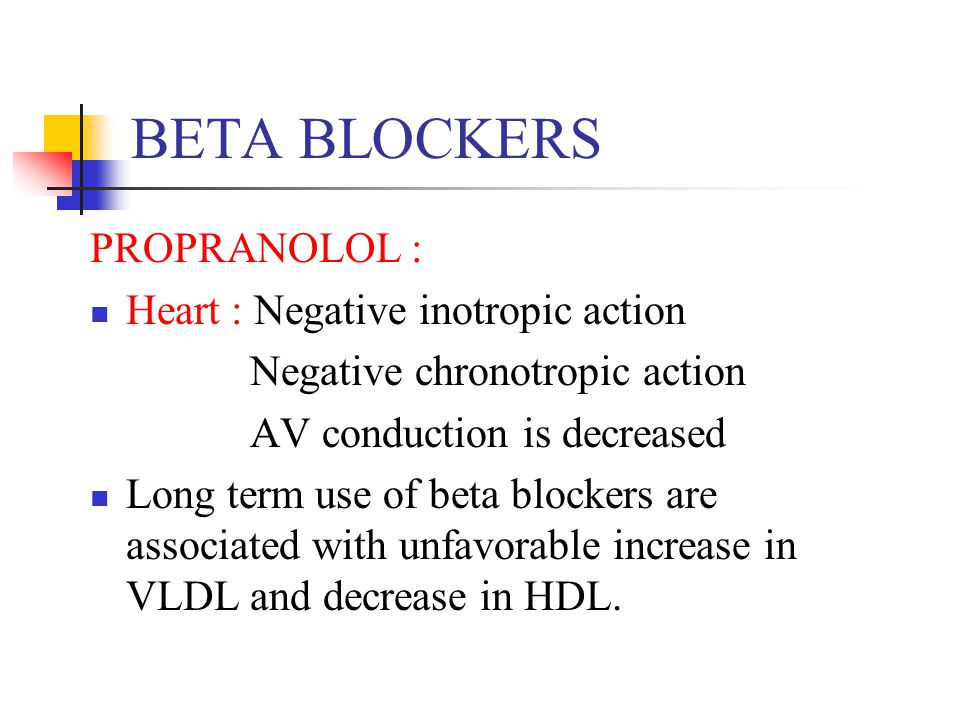
Sowinski KM Burlew BS Johnson JA Racial differences in sensitivity to the negative chronotropic effects of propranolol in healthy men Clin Pharmacol Ther 57 1995. When access to beta-receptor sites is blocked by Propranolol the chronotropic inotropic and vasodilator responses to beta-adrenergic stimulation are decreased proportionately.

For more information ask your doctor or pharmacist.
Propranolol is a negative chronotropic effect. When access to beta-receptor sites is blocked by Propranolol the chronotropic inotropic and vasodilator responses to beta-adrenergic stimulation are decreased proportionately. At dosages greater than required for beta blockade Propranolol also exerts a quinidine-like or anesthetic-like membrane action which affects the cardiac action potential. The significance of the membrane action.
Sowinski KM Burlew BS Johnson JA Racial differences in sensitivity to the negative chronotropic effects of propranolol in healthy men Clin Pharmacol Ther 57 1995. Krauss XH Schalekamp MA Kolsters G et al Effects of chronic beta-adrenergic blockade on systemic and renal haemodynamic responses to hyperosmotic saline in hypertensive patients Clin Sci 43 1972. Meta-analysis of Effect of Statins in Patients with COVID-19.
American Journal of Cardiology Vol134 p153-155. Relation of Statin Use Prior to Admission to Severity and Recovery Among COVID-19 Inpatients. American Journal of Cardiology Vol136 p149-155.
Hospital-Level Disparities in the Outcomes of Acute Myocardial. A substance that has a bathmotropic effect is known as a bathmotrope. Then the resting potential becomes progressively less negative more and more sodium channels are opened and an action potential is generated.
The electrical potential at which this occurs is called the threshold potential. Citation needed As various drugs and other factors act on the resting potential and bring it. This subclass presents more negative chronotropic and inotropic effects than the dihydropyridine subclass and.
Randomized placebo-controlled study patients were treated four-times daily with 90 mg of diltiazem 60 mg of propranolol or a combination of 90 mg of diltiazem and 60 mg of propranolol. The results indicated that diltiazem was more effective in improving exercise tolerance. The negative chronotropic and inotropic effects lead to a decreased oxygen demand.
That is how angina improves after beta-blocker usage. These medications also prolong the atrial refractory periods and have a potent antiarrhythmic effect. Beta-blockers classify as either non-selective and beta-1 selective.
There are also beta-2 and beta-3 selective drugs. Neither has a known clinical purpose. Either increases levels of the other by decreasing metabolism.
Increased serum levels of both agents. Additive negative inotropic effects. Protriptyline and flecainide both increase QTc interval.
Tell the doctor if you have any side effect that bothers you or that does not go away. These are not all the possible side effects of Dobutamine. For more information ask your doctor or pharmacist.
Call your doctor for medical advice about side effects. You may report side effects to FDA at 1-800-FDA-1088. Dobutamine Injection USP is 12-benzenediol 4-2-3-4-hydro-xyphenyl.
Finally it is important to remember that initially beta-blocker therapy causes negative inotropic and chronotropic effects while the improvements in left ventricular function develop over time. It is a presynaptic receptor causing negative feedback on for example norepinephrine NE. When NE is released into the synapse it feeds back on the α 2 receptor causing less NE release from the presynaptic neuron.
This decreases the effect of NE. There are also α 2 receptors on the nerve terminal membrane of the post-synaptic adrenergic neuron. This contrasts with the effect of nonselective beta-blockers which completely reverse the vasodilating effects of epinephrine.
2 In asthmatic patients metoprolol reduces FEV 1 and FVC significantly less than a nonselective beta-blocker propranolol at equivalent beta 1-receptor blocking doses.